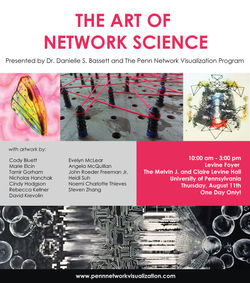 |  |  |  |
|---|---|---|---|
 |  |  |
This summer I participated in the University of Pennsylvania Network Visualization Program under the guidance of Dr. Danielle Bassett. This research initiative focused on synthesizing art and engineering to develop new ways of visualizing network based data.
As engineering fields advance and become increasingly complex, visualizations tools become increasingly critical in understanding complex systems. The challenge of this internship was to create tools that would accurately depict the scientific data or concept from various labs across the country. These visualizations translate the heavy scientific concepts and help foster inter-disciplinary collaboration among scientists, artists and the general public. They are key in enhancing scientific research, increasing dialog between artistic and scientific communities and optimizing educational efforts to teach children about network science.

The Network Behind An Image
This Piece was inspired by Dr. Ann Hermundstad’s lecture entitled What and How the Brain Sees . In her lecture, she discussed the interlinking network between one's environment, eyes and brain. She explained how the eye breaks down an image and uses variability to determine what the eye processes. The brain encodes such variable patterns and translates them into the image we see. As she explained, this happens in the interneurons in the retina and is essential to understanding the way our eye and brain work. One essential step in this process is the encoding of the image in binary to the brain. Such binary sequences are viewed as “words” and are reshaped by network correlations when sent to the brain.
I wanted to illustrate this complex process. In short, the process includes breaking down an image into pixels, sorting it by variability, transferring this information to light ways, then into electrical pulses (depicted as both a circuit board and voltage readings) and then finally into a binary code that the brain understands, and ultimately, back into its reflected image.

The Brain: A Synthesis of Many Networks.
A common message throughout all of the lectures is the interconnection between many of the systems and networks with which we are familiar. Almost every lecture opened with a slide explaining the concept of nodes and edges and with images of common networks. Our lectures ranged from physics and bioengineering to finance and anthropology. Throughout all of these lectures, the underlying principle was consistently the centrality of networks. We were shown that no matter the system and its physical characterizations,various networks have many similarities and can be broken down into mathematical-like schematics.
I wanted to illustrate exactly that-- and how the brain can be viewed as a synthesis of many networks. To accomplish this, I created an acrylic book. With the brain as my back cover, each page has a painting of a system with which we are familiar. Next to each segment of the painting, I etched the mathematical schematic of the corresponding system. When all of the mathematical schematics are combined, they form the network of the brain. This can be seen on the front cover and also when the book is closed.
.

Tagging the Kidney
This painting titled “Tagging the Kidney” is a visualization of my research project on Measuring Allele-Specific Expression in Mouse Tissues in the Raj Lab. I, under the supervision of Uschi Symmons, quantified allele-specific expression using RNA FISH (Fluorescence in situ Hybridization) on the single cell level. The painting, a series of clear layers and digital images, aims to visualize the power of this technique. It demonstrates the power of tagging various RNA molecules in the individual cells of the mouse kidney. It shows the significance of gene expression on both the population and individual cell level by depicting enlarged tagged cells layered on an image of the entire tagged kidney. The painting simultaneously brings you through the space of a kidney slice, zooming in and out, just as the microscope does.
